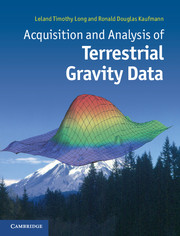Book contents
- Frontmatter
- Contents
- Preface
- 1 Gravitational attraction
- 2 Instruments and data reduction
- 3 Field acquisition of gravity data
- 4 Graphical representation of the anomalous field
- 5 Manipulation of the gravity field
- 6 Interpretation of density structure
- 7 The inversion of gravity data
- 8 Experimental isostasy
- A Appendix ACommon definitions and equations in potential theory
- B Appendix BGlossary of symbols
- References
- Index
Preface
Published online by Cambridge University Press: 05 February 2013
- Frontmatter
- Contents
- Preface
- 1 Gravitational attraction
- 2 Instruments and data reduction
- 3 Field acquisition of gravity data
- 4 Graphical representation of the anomalous field
- 5 Manipulation of the gravity field
- 6 Interpretation of density structure
- 7 The inversion of gravity data
- 8 Experimental isostasy
- A Appendix ACommon definitions and equations in potential theory
- B Appendix BGlossary of symbols
- References
- Index
Summary
Gravity data acquisition and analysis is most often presented in outline form as one of the smaller chapters in books on general geophysical exploration methods. This limited description means that the details of field techniques and data analysis are lost or greatly abbreviated and left to the individual to learn through experience. The objective of this book is to offer a detailed presentation of gravity data acquisition and analysis in a single package. The examples are taken from geophysical engineering problems as well as the analysis of regional and global data.
The objective is to completely cover the information needed for a novice to understand how and why gravity data are acquired and analyzed. A student completing a course using this text could easily acquire gravity data and would be prepared to initiate independent research on the analysis of potential data. A consulting geophysicist will find a base of both theoretical- and application-oriented information in this text, while a geologist or engineer can use this book to better understand the advantages and limitations of the gravity method. The general approach of this text has evolved over the past 20 years through experience gained from the acquisition of more than 40,000 values of gravity and in teaching courses in potential methods.
The text is intended for a wide range of users. It is written so that the basic applications are easily understood by those with limited training in mathematics. At the same time, the text occasionally introduces more advanced topics from potential theory for those with greater skills in mathematics. The text does not present extensive equations for the many possible specific models. Some simple shapes lead to complex equations that are computationally intense and generally of little practical use. Instead, the text presents the simpler models as a means of illustrating concepts or as a method of approximating structures. Sufficient background is presented in the equations and analysis techniques for those wishing to create their own more detailed models. In general, methods that allow automatic modeling of the gravity fields using approximations will be emphasized. Inversion methods are presented for the geophysicists needing more advanced analysis techniques for larger datasets.
- Type
- Chapter
- Information
- Publisher: Cambridge University PressPrint publication year: 2013

